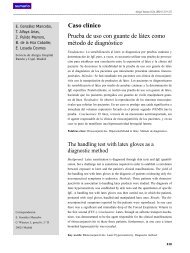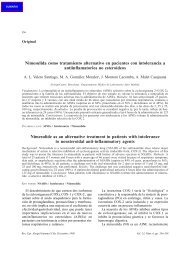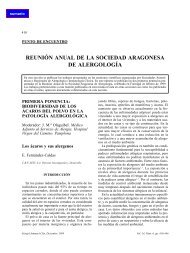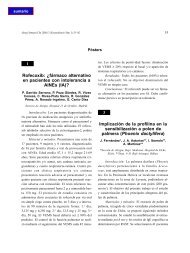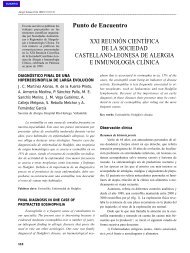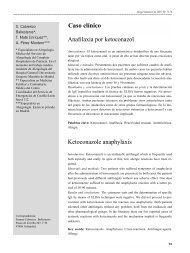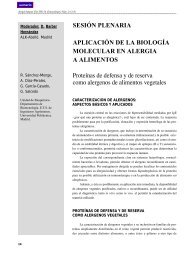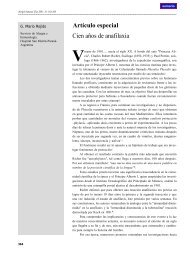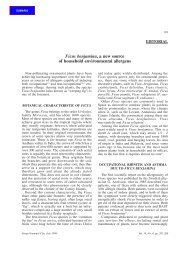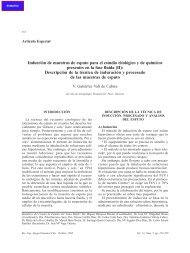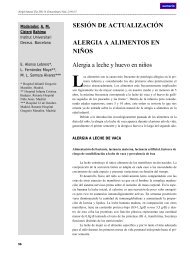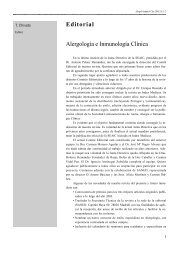Antihistamines: a review
Antihistamines: a review
Antihistamines: a review
You also want an ePaper? Increase the reach of your titles
YUMPU automatically turns print PDFs into web optimized ePapers that Google loves.
306 I. J‡uregui Presa Volume 14<br />
Fig. 2. Ventricular tachycardia of the "torsades de pointes" variety. Simultaneous recording of leads I, II, III and V1.<br />
our country 10 . Their plasma half-life is about 24<br />
hours, the same as the duration of the suppression<br />
of the skin test with histamine 57 (Table II). The<br />
rationale for their retarded-release formulations<br />
("Repetabs") is mainly to delay the plasma concentration<br />
peak in order to reduce the adverse<br />
CNS 4 effects representing the main problem of<br />
these drugs: at therapeutic dosages they cause<br />
somnolence, abatement of the reflexes and electroencephalographic<br />
(EEG) changes 58 .<br />
Diphenhydramine. In Spain, this drug is at present<br />
only available in some anticatarrhal associations<br />
and as an hypnotic 10 because of the intensity<br />
of its CNS effects 58 . Its derivative dimenhydrinate<br />
is widely used in our country as an antikinetotic.<br />
Clemastine. This is the prototype of the ethanolamines,<br />
the same chemical family as diphenhydramine,<br />
in Spain. It is currently available only<br />
for oral administration 10 . Its plasma half-life is 7-<br />
12 hours, with a skin test suppression period of<br />
12-24 hours. Its anticholinergic, antidopaminergic<br />
and antiserotoninergic affects are similar to those<br />
of the other "classical" antihistamines 9 .<br />
Cyproheptadine and azatadine. With a very<br />
close structural correlation between them, the two<br />
classical piperidines are characterised by their<br />
potent antiserotoninergic, anticholinergic and<br />
sedative effects. The first one of these effects has<br />
been taken advantage of for indications such as<br />
Cushing's syndrome, the carcinoid syndrome or<br />
vascular migraine 9 , and also in the management of<br />
hypo-orexia 10 . Azatadine is the parent compound<br />
of loratadine.<br />
Hydroxyzine. This drug has an elimination halflife<br />
of 14-20 hours in the adult and concentrates<br />
rapidly in the skin, so that sustained high skin<br />
concentrations can be observed after both single<br />
and multiple dosing; it can inhibit the response to<br />
histamine during at least 36 hours after a single<br />
dose in healthy adult subjects 4 . It is classically<br />
considered to be the most effective antihistamine<br />
for the management of pruritus 59 , an effect that is<br />
in part attributable to its potent sedative action<br />
(which has been taken advantage of for therapeutic<br />
purposes).<br />
Cinarizine and flunarizine. These classical<br />
piperazines, which are structurally different from<br />
hydroxyzine and cetirizine, have been mostly<br />
used for their antikinetotic activity. Flunarizine is<br />
the bi-fluorinated derivative of cinarizine and also<br />
has a calcium channel-blocking action 6 ; it is used<br />
for prophylaxis of migraine and vertigo and in the<br />
management of cerebral and peripheral vascular<br />
conditions.<br />
Promethazine. An ethylamine derivative of<br />
phenothiazine, this compound has the same sedative<br />
characteristics of other phenothiazine drugs,<br />
together with potent antihistamine and antikineto-




